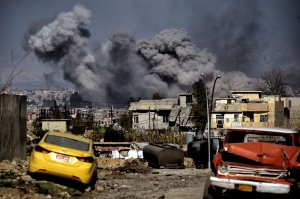The U.S. military is investigating whether it was responsible for the deaths of nearly 300 Syrian and Iraqi civilians in three different sets of airstrikes this month.

Civilian casualties have been alleged in all three instances, but each situation is different and complex, a U.S. defense official said. So far, there is no indication of a breakdown in U.S. military procedures governing airstrikes, the official stressed, and the U.S. is not contemplating a pause in military operations.
But the potential that the U.S. is responsible for some, or all, of the deaths is considered serious enough that Central Command, which oversees operations in Iraq and Syria, is working around the clock trying to assess exactly what happened, the official said.
The possibility of U.S. military responsibility in civilian deaths illustrates the growing challenge of conducting increased airstrikes in the densely populated neighborhoods of both west Mosul and Raqqa, officials said.
The most extensive case involves western Mosul. The U.S. military is trying to determine if sometime between March 17 and March 23, bombs dropped in a neighborhood by U.S. warplanes resulted in the deaths of more than 200 civilians. The incidents military officials are looking into are based largely on local reports and social media accounts of the strikes.
“The coalition conducted several strikes near Mosul and we will provide this information to our civilian casualty team for further investigation,” Pentagon spokesman Eric Pahon said.
Related: Click here for photos from a Los Angeles Times photographer currently covering Mosul.
Separately, a U.S. defense official told CNN the military is trying to determine how many civilians were killed in the Mosul strikes and how it may have happened. Some of the questions the military is asking are: Did the U.S. strike the buildings that the civilians were allegedly killed in, and if so, why did the U.S. not know civilians were there? Did U.S. forces strike the wrong buildings and not what they meant to target? How many civilians might have been killed? Were they killed by U.S. bombs, or was there a secondary explosion from the bombing or blast waves that caused further destruction?
The U.S. has not ruled out the possibility that ISIS was using some people as human shields, but the official who has direct knowledge of the investigation said there is urgency to find out if the U.S. was responsible because of the scope of what may have happened.
However, U.S. officials cautioned that local reports can be difficult to verify because the U.S. does not have anyone on the ground, and may be unreliable because they lack the precise detail the military wants to have to determine what happened.
The chairman of Nineveh Provincial Council in Iraq, Bashar al Kiki, told CNN that at least 200 people were killed in the western Mosul neighborhoods of al Jadidah, al Amel and al Yarmouk in airstrikes by the U.S.-led coalition and Iraqi Air Force on March 22 and March 23. The Iraqi official demanded an end to military operations in the area until civilians’ safety can be guaranteed.
“Most of (those) killed are civilians, among them children and women,” al Kiki told CNN. “Nineveh Provincial Council members call on Iraqi security forces to stop the military operations in these areas immediately and until we guarantee the safety of hundreds of thousands of civilians.”

And Basma Bassem, a member of the Mosul City Council, told CNN that the death toll could rise significantly because rescue operations are still underway.
The Pentagon spokesman said the U.S. is studying the allegations. “The coalition has opened a formal civilian casualty credibility assessment on this allegation, and we are currently analyzing conflicting allegations and all possible strikes in that area,” Pahon said.
The U.S. military also has begun a formal investigation into a March 16 airstrike in northern Syria, where local reports say a mosque was struck and more than 40 people died. For days the Pentagon said there were no civilian casualties in the March 16 incident, even as numerous social media reports showed images of bodies being carried out of the rubble.
In the initial hours following the strike by U.S. drones and aircraft, the Pentagon had been adamant that it had only hit a building some 40 feet away from the mosque, where it said al Qaeda members were holding a meeting.
“We do not currently assess there were any civilian casualties,” Pentagon spokesman Captain Jeff Davis told reporters on March 17, the day after the strike. “As always, you know we take extraordinary measures to mitigate the loss of civilian life in our operations.”
At the time, Davis also showed a photo of the still-standing mosque and a larger building a short distance away. Half of that building had been clearly destroyed in an airstrike. The Pentagon could not say if that larger building had any religious use, and would only say it was certain that a meeting of al Qaeda operatives was underway when it was struck. Defense officials said then that they were convinced the target was legitimate and no civilians were present based on lengthy overhead surveillance before and after the strike.
The investigation into the March 16 airstrike will be conducted under Army rules in a so-called “15-6” fact-finding investigation, named after the regulation governing how it will be conducted. Two U.S. defense officials confirmed the investigation has been initiated by the Joint Special Operations Command which conducted the mission. The investigation will eventually be reviewed by Gen. Joseph Votel, head of the US Central Command, who oversees all military operations in the region. Votel can either accept the investigation’s findings, or send it on for further review by military legal authorities, the officials said.
This is not a criminal investigation. But by using this method, an investigating officer is appointed who then has the ability to question U.S. military personnel and review classified material — in this case to determine if civilians were killed. If that determination is made, it will be up to Votel to decide if further action is warranted.
The same investigatory process has been used by Central Command recently in two highly controversial cases. In 2015, a U.S. Air Force AC-130 gunship attacked a hospital in Kunduz, Afghanistan, killing several people. The investigation found that military procedures were not followed, leading to the wrong building being attacked. Most recently, an investigation into the shooting deaths of three Army Special Forces soldiers in Jordan found they were behaving correctly when they entered a Jordanian military base, something that was originally disputed.
In a third instance, Central Command is also reviewing an airstrike against a school building Wednesday near Raqqa. Local activists have said an airstrike may have killed more than 30 civilians seeking shelter there. The U.S. was conducting strikes in the area, the defense official said. Central Command is trying to determine if it hit the correct building, and if civilians whom U.S. military officials did not know about may have been inside.













